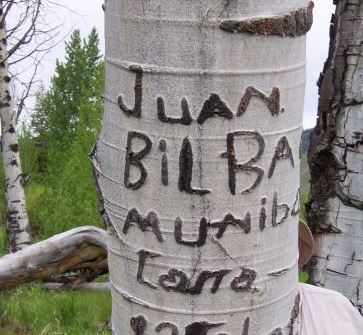
Basque sheepherders created these tree carvings, called arborglyphs, while working in remote areas throughout Idaho during the twentieth century. Loneliness and the need for communication moved the herders to leave their mark on the world around them. Usually written in Basque or Spanish, these arborglyphs record herders’ names, thoughts, and drawings and often represent the only historical data about sheepherders. Herders carved almost exclusively on aspens. As the trees grew, they healed themselves and black scars formed visible designs. On average aspens live less than 100 years; consequently, most of the oldest arborglyphs have already been lost. The threats of decay, fire, and vandalism accelerate the need for arborglyphs to be documented. The tree carving tradition began with the Basques and continues today by herders from Central and South America, most often from Peru and Chile. – Written by Audra Hoyt.